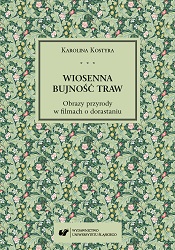Wiosenna bujność traw. Obrazy przyrody w filmach o dorastaniu
Splendor in the Grass. Nature Images in Coming-of-Age Films
Author(s): Karolina Kostyra
Subject(s): Fine Arts / Performing Arts, Film / Cinema / Cinematography
Published by: Wydawnictwo Uniwersytetu Śląskiego
Keywords: coming of age; film about growing up; initiation; transition ritual; nature; film and culture studies
Summary/Abstract: This book analyzes the manifestation of nature in coming of age mov-ies. The constitutive feature of the coming of age film is the presence of the rites of passage into maturity. These rituals follow the initiation schemes described in anthropological works. Usually it comes to them in nature: in forests, in deserts, away from home. Drawing from Jungian psychoanalysis, religious studies and theories concerning myths, tales, symbols, this work draws attention to the symbiotic dependence that connects the film heroes with the life cycle present in nature. Nature at the threshold of adulthood usually appears as a dense, fertile, self-living (though often coincident with the experience of the "human" hero) life. Nature in this approach allows teenagers to distance themselves from familiar areas and embrace new, exciting sensations. Summer holidays allow to experience adventure of adolescence – the background of most coming of age movies.The first part of the book entitled Szałasy concerns stories in which the main motive is a journey towards adulthood, sometimes forced, sometimes funded at own request. The school of survival, which is located in the wilderness, teaches independence and courage. Films revolving around the survival growing up type force the protagonist to kindle bonfires, hunt animals – to create metaphorical or literal huts. In Stand By Me (1986, directed by R. Reiner), boys from an American town from the late 1950s are going on a trek along the railway tracks to see the corpse of their peer hidden in the forest. In The Kings of Summer (2013, directed by J. Vogt-Roberts), modern high school students decide to escape from home comfort to the surrounding forest, where they build their hut styl-ized for Thoreau. In Walkabout (1971, directed by N. Roeg) a teenage heroine and her younger brother orphaned by her father wander through the Australian outback, while in the Polish short documentary Płyną tratwy (1962, directed by W. Ślesicki) Mietek from the Augustów village is goes for the first time to work by the timber rafting. The stories quoted are bond by the rite of passage with risky initiation attempts and nature, which is great, lofty and dangerous. Letniska – the second part of the book – focuses on summer holidays, love and nature, which more than a dense jungle resemble an overgrown park or an en-chanted garden. Nature harnessed by the experience of a vacationer no longer encourages crazy trips, but to walk and not to sleep all night long. In such circum-stances, teenagers from the pioneer camp in One Hundred Days After Childhood(1974, directed by S. Sołowjow) experience a painful love initiation. In A Day in the Country (1936) by Jean Renoir, on Sunday spent in nature, a young girl leaves her parents for a moment to experience the true feeling in love for the first and last time. Dancing w kwaterze Hitlera (1968, directed by J. Batory) and Crazed Fruit (1956, directed by Kô Nakahira) tell about summer love in a more bitter and angry tone. The film crowning the second chapter, and in a sense the whole work, is By the River Nowhere (1991, directed by A. Barański), which in perverse way uses the motives of the coming of age cinema, but does not differ from the genre.The book's focal point is the attempt to determine the essence of youth, which is subject to the story of puberty, as well as to define what is left behind by the time of adolescence. Youth is defined not as a state but as a process exist-ing as much as it still exceeds itself. The story revolving around the initiation scenario operates with a certain tonality, offering the viewer not only a specific mood (nostalgia or joyful expectation), but also a vision of great and short youth. Its volatility is emphasized by the clearly marked "here and now" in which the main part of the story takes place. The moment is struck by impressionism in the loud croaking of frogs, the sound of wind in the leaves of the trees or the shots of the sun looking out from behind the branches.
Series: Radio, Telewizja, Film, Internet
- E-ISBN-13: 978-83-226-3498-1
- Print-ISBN-13: 978-83-226-3497-4
- Page Count: 184
- Publication Year: 2019
- Language: Polish
- eBook-PDF
- Table of Content
- Introduction

